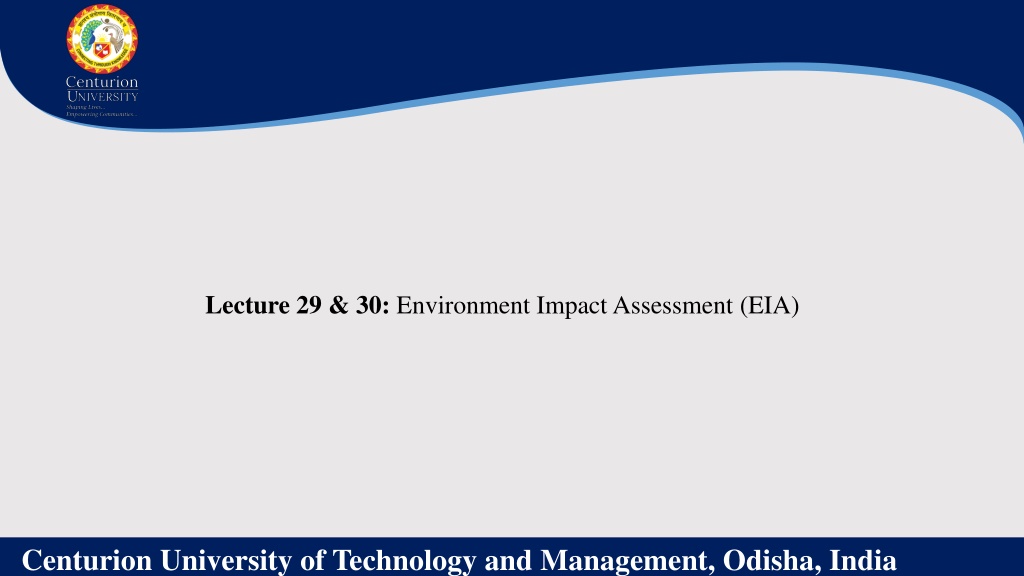Environmental Impact Assessment (EIA) Evolution and Importance at Centurion University
The Environmental Impact Assessment (EIA) process evaluates the environmental impacts of proposed projects, aiming to minimize adverse effects. Originating in the 1970s, EIA has evolved globally, becoming a key policy tool for sustainable development. In India, EIA began in 1976-77 and was later made statutory in 1986. Key laws like the Environment (Protection) Act and initiatives like the Environmental Information System (ENVIS) highlight India's commitment to effective environmental assessment practices.
Download Presentation

Please find below an Image/Link to download the presentation.
The content on the website is provided AS IS for your information and personal use only. It may not be sold, licensed, or shared on other websites without obtaining consent from the author. Download presentation by click this link. If you encounter any issues during the download, it is possible that the publisher has removed the file from their server.
E N D
Presentation Transcript
Lecture 29 & 30: Environment Impact Assessment (EIA) Centurion University of Technology and Management, Odisha, India
It is a process of evaluating the likely environmental impacts of a proposed project or development, taking into account inter-related socio-economic, cultural, and human-health impacts, both beneficial and adverse. EIA is a tool used to assess the positive and negative environmental, economic, and social impacts of a project. This is used to predict the environmental impacts of a project in the pre-planning stage itself so that decisions can be taken to reduce the adverse impacts. Objectives of Environmental Impact Assessment 1.Identifying, predicting, and evaluating economic, environmental, and social impacts of development activities. 2.Providing information on the environmental consequences for decision making. 3.Promoting environmentally sound and suitable development by identifying appropriate alternatives and mitigation measures. Centurion University of Technology and Management, Odisha, India
Evolution & History of EIA EIA is termed as one of the best policy innovations in the 1900s. The main aim of EIA is to conserve the environment and bring out the best combination of economic and environmental costs and benefits. Read the below-mentioned points to understand the Environmental Impact Assessment evolution and history: 1.The birth of EIA is dated back to the 1970s. In 1969, The USA had brought its first National Environment Policy Act (NEPA) 1969. 2.The EIA was initially practised by developed nations but slowly it was also introduced in developing nations including India. 3.Columbia and the Philippines are the earliest examples of developing nations who introduced EIA in their policies. Columbia brought it in 1974 while the Philippines in 1978. 4.Worldwide, EIA is now practised in more than 100 countries. By the mid-1990s, some 110 countries applied EIA as a major environmental policy. 5.In 1989, EIA was adopted as the major development project by the World Bank. Centurion University of Technology and Management, Odisha, India
Environmental Impact Assessment In India EIA started in India in 1976-77 when the Planning Commission directed the Department of Science & Technology to assess the river valley projects from the point of view of the environment. This was extended for all those projects that required approval from the Public Investment Board. Then, in 1986, the government enacted the Environment (Protection) Act which made EIA statutory. The other main laws in this regard are the Indian Wildlife (Protection) Act (1972), the Water Act (1974), the Air (Prevention and Control of Pollution) Act (1981), and the Biological Diversity Act (2002). In 1982, the Ministry of Environment, Forest and Climate Change set up the Environmental Information System (ENVIS) to collect, collate, storing, retrieving and disseminating information related to the environment sector. This serves as a web-based distributed network of subject-specific databases. The chief purpose of the ENVIS is to integrate all countrywide efforts to collect, store, disseminate, and use environment-information for better managing environmental assessment activities. Centurion University of Technology and Management, Odisha, India























